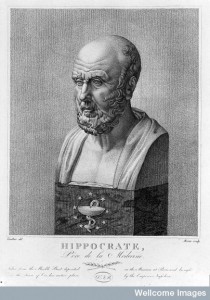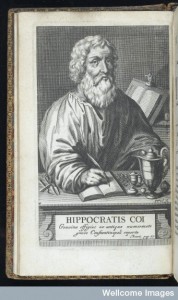by Helen King
Did Hippocrates develop a remedy against baldness because he was worried about his own hair loss? As readers of my previous posts here will know, normally when Hippocrates gets dragged into a modern medical discussion it’s to validate whatever the writer is trying to sell; for example, watercress. But in the discussions of baldness, the message is a different one; not that we should look to Hippocrates, but that despite the ‘fact’ that even Hippocrates couldn’t find a cure for it, there may be one now.
The cure for baldness?
I started looking into this because the Wikipedia article on Hippocrates currently contains a claim that ‘The most severe form of hair loss and baldness is called the Hippocratic form.’ The source given is a dead web link, to ‘The dilemma of balding solve by father of medicine Hippocrates”. Healthy Hair Highlights News. 15 August 2011’. Going through the article’s history shows that the sentence was added to the article on 1 October 2011. The original link was reported as dead in April 2012, but I think it’s reasonable to suppose that it originally went to a story that’s very common on the internet to the effect that:
Hippocrates had a personal interest in finding a cure for baldness as he suffered from hair loss. He developed a number of different treatments including a mixture of horseradish, cumin, pigeon droppings, and nettles to the scalp. This and other treatments failed to work and he lost the rest of his hair.
This version comes from a story posted 17 September 2012 on ‘Alopecia World’.
Was ‘Hippocrates’ bald?
Clearly this has a lot in common with other myths about the historical Hippocrates, in that it tries to create a person and a story. Hippocrates’ hair was not, however, a fixed point in the long tradition of trying to imagine what he looked like. Sometimes, as here from an image of 1665, he was shown with a full head of hair.
But because one of the texts in the ‘Hippocratic corpus’, The Physician, describes how a doctor should look healthy, one image that probably originated in the late third century BC represented him to match this text, as ‘a well-fed, confident, partly bald elderly man’ (Pinault, p.17). Indeed, sometimes he was shown with his head covered, to hide his baldness, a story taken from one of the earliest attempts to create a biography for Hippocrates, section 12 of the Vita Hippocratis Secundum Soranum. He was shown like this in 1699 by Daniel Le Clerc.
In his 1806 lecture ‘On the opinions and modes of practice of Hippocrates’, Benjamin Rush represented him with plenty of hair, but didn’t specify whether this was on top of his head as well, writing that Hippocrates was Mild in his appearance, and dignified in his deportment, with gray hairs loosely flowing over his shoulders…
So, did the remedy work?
But back to those modern manifestations of the myth of Hippocrates’ baldness. Here, sometimes the remedy is simply a failure. For example, from a 2012 version online, he
personally grappled with male pattern baldness. He prescribed himself and fellow chrome domes a topical concoction of opium, horseradish, pigeon droppings, beetroot and spices. It didn’t stop anyone’s hairline from receding
or from a more recent site which is telling the same story:
Hippocrates himself was plagued by male pattern baldness and concocted a potion which he believed would cure the problem. Containing beetroot, horseradish, pigeon droppings, spices and opium, it was an abject failure.
But the remedy may be even worse than a failure. In some versions, the remedy is not only presented as ineffective, but also as positively harmful. For example, from a hair loss forum in 2005, he:
recommended a putrid mixture of cumin, pigeon droppings, horseradish and beetroot as a cure for baldness. However, the concoction proved disastrous. Hippocrates became ever balder, so much so that, even now, extreme cases of hair loss are referred to as “Hippocratic baldness”.
So, don’t try this yourselves… The story is regularly retold to preface any apparent breakthrough in treating male pattern baldness. For example, in 16 May 2007 The Times described Hippocrates’ remedy as a blend of pigeon droppings, cumin, horseradish and beet-root. Interestingly, an earlier story on the same topic in the same newspaper – ‘Then and now: Baldness’ – instead had Hippocrates slapping on a mixture of opium, horseradish, pigeon droppings and beetroot. It didn’t work. He got so sparse that hairlessness became called “Hippocratic baldness”.
This is just one example of how opium replaces cumin in many of the retellings of the story. For example, Hippocrates used an ointment of opium and essence of roses. His hair failed to grow back. He then tried a formulation of acacia oil and wine. Again, no luck, a version which featured in Charles Vallis, Hair Transplantation for the Treatment of Male Pattern Baldness (1982) as opium with the essence of lilies or roses, mixed with wine and olive oil.
Whose remedy was it anyway?
You may by now be wondering: where does this remedy come from? It is, indeed, from the Hippocratic corpus. But it has noting to do with male pattern baldness, let alone with Hippocrates himself.And it doesn’t include opium. Instead, it’s from the gynecological treatise, Diseases of Women 2.189. Laurence Totelin translates this recipe for hair loss in women as If she loses hair, apply as a cataplasm: cumin or excrement of pigeons, or crushed radish, or <rub?> with crushed onion, or beet, or nettle (p. 262). Historically, the use of irritant substances – usually combined with something to make the whole thing smell more appealing, as in the lilies and roses in some versions – has been standard for hair regrowth remedies across the ages, whether for men or for women.
Hairs of Hippocrates? No. Nothing to do with the historical Hippocrates, the repetition of this recipe for hair loss rules the internet, and acts as a useful warning that nothing should be taken at face value where Hippocrates is concerned!
Further reading:
Benjamin Rush, Sixteen introductory lectures, to courses of lectures upon the institutes and practice of medicine, with a syllabus of the latter. To which are added, Two lectures upon the pleasures of the senses and of the mind, with an inquiry into their proximate cause, Philadelphia: Bradford and Innskeep, 1811, Lecture 12 pp. 274-294.
Jody Rubin Pinault, Hippocratic Lives and Legends (1992)
Laurence Totelin, Hippocratic Recipes: Oral and Written Transmission of Pharmacological Knowledge in Fifth- and Fourth-Century Greece (2009)



